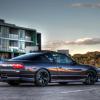Bang For Buck Tyres.
Announcements
-
Similar Content
-
Latest Posts
-
I'm actually not sure - I think it was "Stealth Performance" (It really is near impossible to find a FEMALE 1/8BSPT to 1/8NPT male at ALL) but having the thing leveraged on a 90 degree angle on a small aluminium fitting is not too smart. Also in not too smart, I've drilled out the center of the broken fitting so there's maybe 0.00001mm of thread to bite into, so yeah. I may have to get it drilled/tapped/plugged entirely. Given I could conceivably tap a thread/adapter/pressure line in any point in the oil system I suppose it's feasible to run a line to the Nissan Sensor to keep the dash working. Do these exist in AN fittings and the like? Like an AN fitting that has a NPT (or other?) thread as well for putting a sensor in?
-
I would agree. There will be an amount of boost you could run safely with an otherwise factory system, but it would be low enough to not be worth the cost. And if you are reliving your 20s, you know a 'little bit' was never enough. Personally, if I didn't want to spend the money, then stick with NA bolt-ons, and maybe a tune.
-
By Dose Pipe Sutututu · Posted
Fuark, at least the motor survived. What brand was the fitting that snapped? -
Wrong question. There's no point in spending the rather large sum of cash and effort to add turbo, without taking it to the "sensible" limit of the motor itself. If you have to upgrade injectors, etc, then so be it. That is a tiny fraction of what it will cost you to turbo it.






Recommended Posts
Create an account or sign in to comment
You need to be a member in order to leave a comment
Create an account
Sign up for a new account in our community. It's easy!
Register a new accountSign in
Already have an account? Sign in here.
Sign In Now